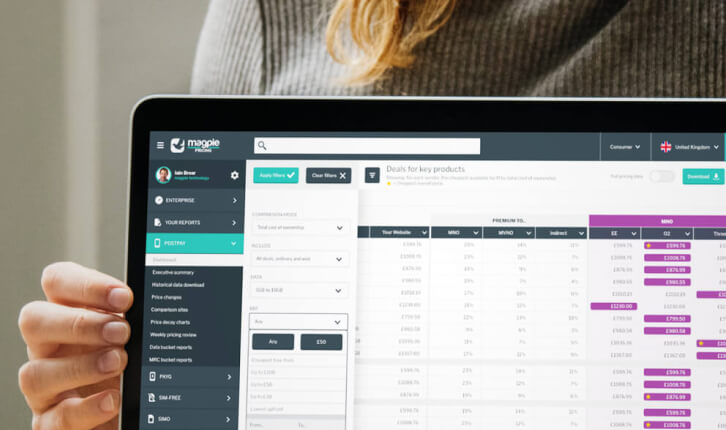Published on: November 4, 2022 | Last updated on: July 22, 2024 |
In the old days, marketing was very much about showing people where to find brick and mortar stores that sold their favourite products.
Now, though, things have changed.
Thanks to the internet, companies can now use many different channels to present their brands and products to the world. Using a combination of channels in an effective omnichannel ecommerce strategy can mean big success.
In this article, we look at omnichannel ecommerce, explaining what it is, why it’s important and how you can use it to help grow your business on the digital shelf.

Put simply, omnichannel ecommerce is the use of various different platforms to sell your goods and/or services.
It differs from multichannel ecommerce in the sense that each platform serves as part of an integrated user journey, as opposed to fulfilling just one specific function.
Omnichannel ecommerce focuses primarily on the digital marketplace but can involve physical stores as well. For example, if your brand has a brick and mortar shop from which you are running an event, it is possible to use your omnichannel ecommerce journey to signpost customers to that shop.
At the same time, if you are focusing purely on virtual spaces, omnichannel ecommerce can be leveraged across all sorts of different media to attract customers to your company.
According to a recent study by the Harvard Business Review, around 73% of shoppers use multiple channels while purchasing online.
This shows that, in today’s channel-rich environment, maintaining consistency is important if you want consumers to trust your brand and (eventually) buy your products.
No matter what digital device or platform they’re using, your customers should enjoy a unified experience with omnichannel ecommerce when buying across the digital shelf.
Having a successful omnichannel ecommerce strategy provides numerous benefits, some of which include:
Omnichannel ecommerce can take different forms depending on what your business needs, when it needs it.
For example, your omnichannel ecommerce strategy might include:
Like most things on the digital shelf, omnichannel ecommerce requires much consideration and planning.
So, you should keep customer experience at the heart of your efforts, and be prepared to test again and again until you get it just right. Remember, this is a marathon, not a sprint.
Want to create an amazing omnichannel ecommerce strategy? Here are a few tips that will help you get started:
You shouldn’t make assumptions about your customers; take it from us, their behaviour is almost always unpredictable. Instead, do plenty of prior research into their buying patterns, interests and needs.
Social listening can help with this, as many shoppers nowadays use social media and other online hubs to talk about the brands they love (and loathe). Ask questions, invite feedback and, above all, listen! You’ll be surprised at how much your business can gain by hearing them out.
Whether they’re window shopping at your online store or seeing ads you’ve posted on social media, customer touchpoints are key. But choosing which channels to focus on? Now, that’s the real challenge.
First, you should know where your customers are appearing online, as well as what they’re doing there. Only then can you begin to boost your digital presence in the right places.
Next, identify a clear purpose for each channel. For instance, allocate one mainly to customer interaction, another to news updates, etc. By differentiating between platforms, you’ll establish clear boundaries across your brand that shoppers can easily recognise.
Finally, a successful omnichannel ecommerce strategy doesn’t overreach. If you can’t address every single aspect of your user journey right this second, don’t worry. Concentrate on the areas you can control; trust us – you’ll soon notice an improvement.
Omnichannel ecommerce strategies aren’t purely about sales.
Imagine a potential customer asks a company-related question via social media. Are your customer service team able to reply quickly?
What about cross-channel communication? Have you enabled it so that if a customer adds to cart via one platform, they can still see their item ready for purchase in another?
Websites, campaigns, social media, customer service, automation efforts – omnichannel ecommerce applies to all these areas of your online business and more. It’s therefore imperative that you have the necessary resources and equipment to manage each aspect all the time.
Digital shelf analytics has everything you need to know about your customer base, and its integration into your omnichannel ecosystem is essential.
By integrating digital shelf analytics across all your channels, you’ll be able to better observe how your customers interact with them, and therefore build more user-friendly journeys.
Ever heard of the phrase ‘set it and forget it’? Unfortunately, this is a common problem among businesses looking to win at the digital shelf.
Some companies believe that once they’ve optimised their online sales funnel, they don’t need to do any more work. Nothing could be further from the truth!
With omnichannel ecommerce, you should always be adapting your strategy to reflect the market in its current state. Make changes where needed – and fast. Doing so means you stand a greater chance of staying ahead of your competition.
A one-stop shop for success on the digital shelf, Magpie DBX can help you craft the perfect omnichannel ecommerce strategy, tailored specifically to your business.
We appreciate how difficult it is managing multiple online channels. That’s why our dedicated team of software experts will not only work with you to better understand your ecommerce goals, but also set up the Magpie platform in a way that ensures they are achievable.
Want to learn more about Magpie? Get in touch with us today and request a demo!

Those who work in the worlds of business or marketing may have come across the terms ‘omnichannel’ and ‘multichannel’ at some point.
But what exactly do they mean?
Also, more importantly, how do they affect the way your company interacts with customers?
In this article, we look at both omnichannel ecommerce and multichannel ecommerce, exploring what makes each approach unique and how to decide which one is right for you.

Imagine a shopper has had their eye on one of your products for a really long time. They’ve done all their research, ticked everything off their own internal checklist – they’re ready to go.
Now imagine, for some reason or another, they won’t convert. Can’t bring themselves to do it.
Eventually, they abandon their cart altogether, leaving you (once again!) without a sale.
Checkout abandonment is a common occurrence on the digital shelf, mainly because of the choice customers have nowadays. How are you going to create a sense of certainty with a purchase when they’ve got all this competition staring them in the face?
In this article, we explore what causes checkout abandonment and how you can prevent it from harming your business’s bottom line.

There are two kinds of people in this world: those who love data and Excel sheets… and normal people. Or rather, people who might not always have the time or enthusiasm needed to delve into deep CSV files of raw data in order to extract what really matters and translate it into actionable information.
Here at stickee, we believe complex data shouldn’t get in the way of decisions, but instead help you make them. The amount of data you’re generating can seem a little overwhelming at first, but harnessing its power could help you make better choices for your business. Let’s take a look at big data and the impact it can have…
Want to learn more about how Magpie DBX can help your business? Get in touch with us and let us show you!



